by JILL SPALDING
As with all great achievements, there is no single way to evaluate this production. A fluorescence on blighted terrain, the Broad is at once an unstinting gift to the city of Los Angeles and a shrewd business move; a starchitect building that is both excellent and compromised; and a vessel for art that reflects both personal taste and a stated agenda.
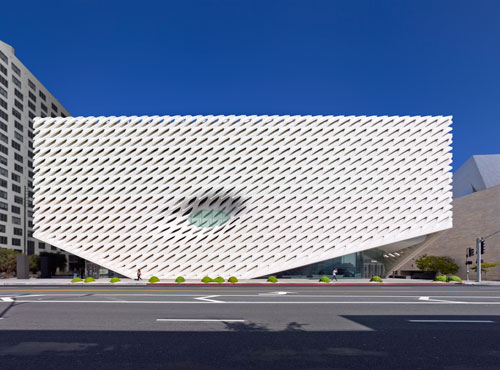
The Broad museum on Grand Avenue in downtown Los Angeles. Photograph: Benny Chan, courtesy of The Broad and DIller Scofidio + Renfro.
Even its opening was bifurcated, with the 17 September opening-opening dinner parsed for meaning as against the following day’s opening dinner. The first headlined topline museum directors, government officials, the socially connected, and art stars Ed Ruscha, John Baldessari, Jeff Koons and Eric Fischl. Remaindered to the second were art-world satellites and artists not collected by Eli and Edythe Broad. David Hockney, on learning he was slotted into Friday, bowed out with a hearing problem; Ed Moses developed a phobia for crowds.
They missed out. They can view the collection later, but not the inaugural tent, itself an architectural marvel with aspirations to Persepolis. Had it stayed, its three-storey stairway alone, zagged up from a parking lot, could have served, like the stepped platform in Times Square, as a Z-generation hangout. They missed the chance, too, to see the Broad floodlit at night, and to tour without the crowds that the first months will draw.
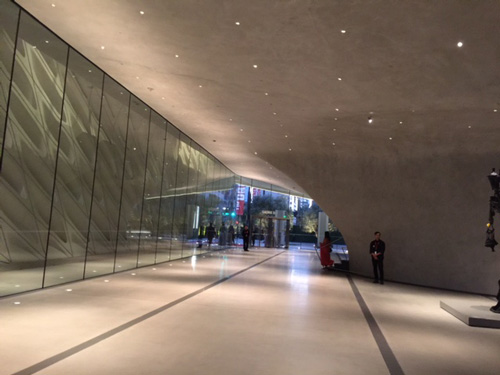
The Broad museum's lobby. Photograph: Iwan Baan, courtesy of The Broad and Diller Scofidio + Renfro.
Advance word was not promising; critics touring in hard hats had dissected it a priori, calling it “bland”, old-fashioned”, “unadventurous”, and “the colour and texture of gefilte fish”. The proof, however, is in the pudding, and the Broad is a sumptuous dessert. A light-punctured semi-trapezoid dimpled by a sea-creature oculus, it springs from the life-sucking drought of Southern California as the almost fully realised actualisation of watery translucency posited by the architect Elizabeth Diller, of the New York practice Diller Scofidio + Renfro, as a “veil” slipped over a “vault”. Blame the “almost” on the cost cutting compounded by fabrication problems (Broad sued the engineering subcontractor) that has flattened what would otherwise have materialised as gossamer dropped over the glass face of a mysterious woman. Precluding the museum’s hoped-for newness, the ensuing delays placed its opening behind that of Pérez Art Museum Miami (PAMM) and New York’s new Whitney, inviting unforeseen comparisons with the forward-looking schemes of two giants of museum architecture.
I knew of them all but, on entering, shed the artspeak. Once past the fibreglass-reinforced-concrete exoskeleton (billed as a “honeycomb”, though its oval windows angled more like quarter notes in the incipient dusk) and through the glassed-in narrow loggia that serves as a psychological Rubicon, I experienced a feeling of wellbeing tinged with awe and a childlike delight. Celestial and beckoning, the biomorphic gray plaster atrium swirls around two formidable sculptures and nothing else: no signage or counter selling tickets, because admission is free.
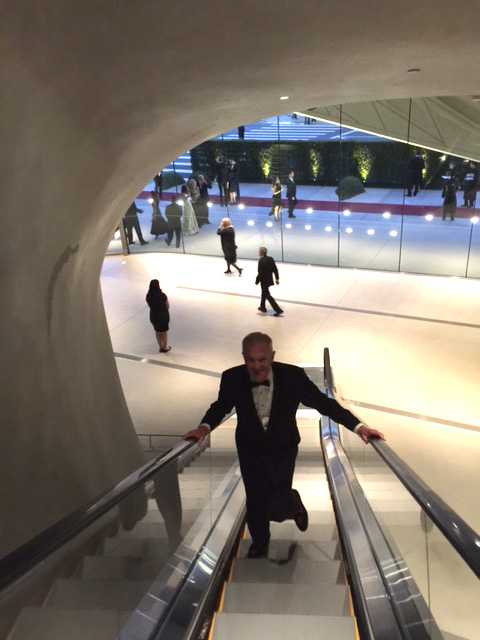
The Broad museum's 105-foot escalator leading from the lobby to the third-floor galleries. Photograph: Jill Spalding.
The atmosphere is ethereal, but the transparency is real. Sunlight dapples the inner surfaces, filtered through the slotted windows as through a loosely woven straw hat. There is a videogame moment for those taking the stairs, where the conservation-cum-storage facility is revealed like a wonder cabinet, and there’s a sci-fi moment for those taking the cylindrical elevator that shoots up through the third floor like an Urs Fischer fountain.
You are here, of course, for the art, most particularly, art from the mid-50s to the present. Referencing New York’s Whitney, MoMA and Metropolitan museums, Eli Broad told the LA Times: “I can’t think of any place that’s going to have a better quality representation than ours.” Two monumental works stand hors-critique; there are no words to convey the complete worlds of Yayoi Kusama’s Infinity Mirrored Room, the closest that serious work gets to magic, and Ragnar Kjartansson’s heart-wrenching nine-screen, sound-and-video The Visitors, which greeted us on the ground floor.
The rest is open to opinion. Circling the generously spaced ground-floor galleries, you meet in succession the first fine examples of today’s darlings; Baldessari, Chris Burden, Takashi Murakami, Andreas Gursky. Wafted up past the storage floor on a 32 metre-high obelisk of an escalator that Khufu would have wanted for his pyramid, you emerge into a 2,787 sq metre, 7 metre-high, sky-lit, column-free, white-walled playground for name art. Ranging, as with a walk over uneven territory, from art to product, the inaugural show’s approximately 250 works, selected by the Broads’ longtime curator and founding director Joanne Heyler, from some 2,000 in their 40-years-in-the-making collection, are exactly as billed; big, bold and familiar. Art snatched from auction, art fairs and dealers; art met at biennials; art bought to hold its own with every other boldface collection of high-priced contemporary art. Not art, however – and here the rub – to disrupt or to challenge. Be it political (William Kentridge) scatological (Goshka Macuga), mystical (Shirin Neshat), camp (Mike Kelley) or just in your face (Damien Hirst), the work here presented is safe in its reputation, secure in its investment value, and clubby in its signage. You can reel off the names as you do sheep to sleep; Andy Warhol, Roy Lichtenstein, Robert Rauschenberg, Jasper Johns, Ellsworth Kelly, Frank Stella, Cy Twombly, Keith Haring, Anselm Kiefer, Barbara Kruger, Koons, Ruscha, Richard Prince, Kusama, Fischl, Chuck Close, Christopher Wool, Glenn Ligon, El Anatsui.
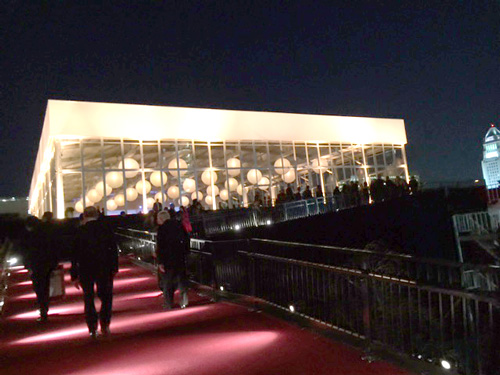
Tent built for the two opening night dinners. Photograph: Jill Spalding.
This said, when at the top of its game, the familiar can be thrilling; such are Johns’s Watchman, Lichtenstein’s I … I’m Sorry, Ruscha’s Norm’s, La Cienaga, on Fire, Kiefer’s Nuremberg, and certain sections of Murakami’s In the Land of the Dead, Stepping on the Tail of a Rainbow. Even Koons’s Balloon Dog (Blue), become a decal on T-shirts and ties, instils joy. Points, too, for bold installations that speak to the moment; Robert Therrien’s monumental takes on mass-produced household furnishings, and Kara Walker’s graphic commentaries on the unacceptable and unspeakable. Speaking to the Broads’ predilections, the works in the inaugural show incorporate abstraction and flirt with the conceptual, but focus in on the day’s big social themes of consumerism, political struggle, self-identity and decadence. Reflecting their stated taste are stirring standouts; Ellen Gallagher’s conscripted associations (eXelento), Mark Bradford’s intersected aggregate Across 110th Street, and Lari Pittman’s radical Like You. There is also a glad play of hot versus cool; Johns’s dense oil paintings facing Twombly’s loose graphics, Koons’s flashy Tulips fronting Wool’s rigorous lettering, Charles Ray’s peppy Fall ’91 eyeing Jeff Wall’s rending Dead Troops Talk. There are welcome surprises, such as Peter Halley’s elegant Freudian Painting, and refreshing palate cleansers such as Bernd and Hilla Becher’s quiet Water Towers. Also good to fully meet, with his wall-length Untitled (Dancing Black Butterflies), local boy-made-good Mark Grotjahn.
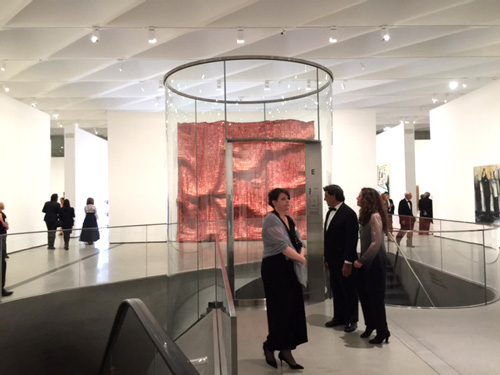
The Broad museum. Cylindrical elevators. Photograph: Jill Spalding.
That said, it is difficult to ignore the signs of bargain syndrome (Broad made his first fortune in most-for-least tract housing) that pursues discount art – a grade-B Richard Diebenkorn, a not-great Georg Baselitz, an OK Thomas Houseago, a second-best Richard Artschwager and average Thomas Struths. Even the Rauschenberg Untitled, while hallowed, leaves you longing for the Van Gogh drawing that the Broads cashed in to purchase it. There are moments of artist-takeover (too many Koons’s displayed at one time). And there is a case to be made for artists, once stellar, to do time in storage (Sam Francis, Tom Otterness). Palpable, too, the awareness of mega-dealer-driven acquisition (the number of works that Larry Gagosian fed in is astounding).
More subtle are the drawbacks, given time’s shifting eye, of the Broads’ much-touted and commendable collecting in depth. Kudos for the layered acquisitions of Leon Golub’s thoughtful figurations, of Jean-Michel Basquiat’s street-tagger exuberance, and Cindy Sherman’s pioneering, career-spanning disruptions. On the other hand, how fresh John Currin looked in his breakout show at Andrea Rosen, and yet an entire roomful of his work, as installed here, now feels dated. And, though I well remember the frisson of my first exposure to new German painting, Neo Rauch palls here, too.
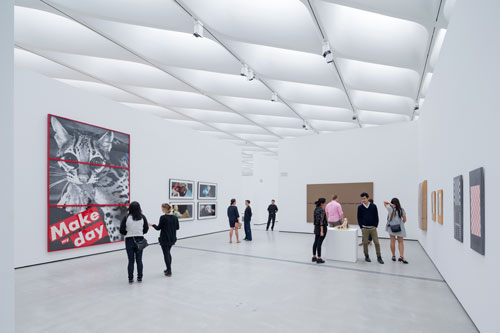
Installation view of works by Barbara Kruger, Cindy Sherman, Richard Prince and Sherrie Levine in The Broad's third-floor galleries. Photograph: Iwan Baan, courtesy of The Broad and DIller Scofidio + Renfro.
Happily, what follows on a close-up is the takeaway. The Broad, as showplace for art, is a marking success. Ambition has met vision, benefaction has matched addiction; the sense of wonder that greets you will usher you out. The building, compromised though its exterior may be, radiates inner beauty. The art is imposing, plentiful and, for the most part, above average. And admission – can I say it enough? – is free.
On to the Broader, where the rubber meets the road. Just as Broad’s reach as a developer has spread from tract homes to museums, so has his vision for Los Angeles inflated from bolstering its key institutions to shaping its blighted downtown Bunker Hill area to rival New York, London and Paris as a cultural capital. A look back at his chess moves reveals a purposeful game. With strings attached to each gift, Broad’s multimillion-dollar contributions underwrote a clutch of distinguished architectural buildings. Broad then gave the Los Angeles County Museum of Art (LACMA) $60m (£40m) to build a freestanding Renzo Piano-designed museum to house his by now impressive art collection, with the understanding that it would find a permanent home there.
By now a billionaire six times over, Broad returned his developer’s eye to Bunker Hill, to bail out its faltering Museum of Contemporary Art (MOCA), contribute to Rafael Moneo’s post-modern refit of its storied cathedral, fund an arts charter school, spur the completion of Frank Gehry’s stalled Disney Hall, and build Grand Park, so named for the Grand Avenue that anchors them all. Broad’s growing vision for converting the not-close-to-grand street into LA’s Champs-Élysées (a comparison he now regrets but that clearly holds true for him) encouraged a new metro station and, on an adjacent group of parking structures, a soon to be green-lighted multi-use complex designed to bring in restaurants, a hotel and the much-needed pedestrian traffic. What remained lacking was the imprimatur of an Arc de Triomphe, and what better to provide it than an eponymous museum?
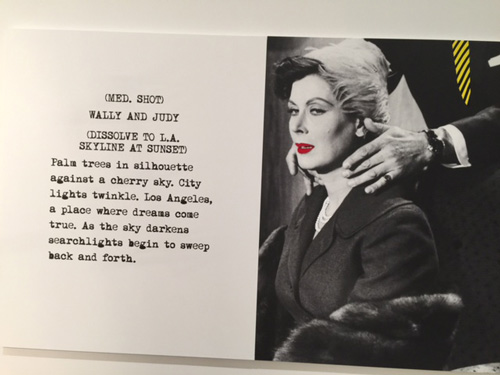
John Baldessari. Take ()/Scene (): Feather Cap, 2014. Varnished inkjet print on canvas with acrylic paint. Photograph: Jill Spalding.
Leaving LACMA to recoup from its in-one-fell-swoop loss with the consolation prize of their monumental Richard Serra Band, the Broads removed their collection to the broader downtown context and gave it 50,000 sq ft of exhibition space to make a significant mark. Its 2,000 artworks shoot past parallel efforts (Peter Brant’s Greenwich museum holds around 1,000: the Mitchell Rales’s Glenstone in Potomac, 800), and, given the guarantee of a staggering $200m endowment, and the recent flurry of acquisition that saw the Broads adding one work a week during the months prior to opening, the collection is assured and additions open-ended.
More tenuous may be Broad’s stated mission to “operate a lending program to art museums and galleries worldwide”, a beneficent write-off that worked well for a small institution with no storage space, but could become problematic should visitors go the distance to see his self-contained museum’s vaunted blue-chip material and not find it. They could cross the street, to view MOCA’s strong collection, which Broad’s newly installed stoplight – pedestrian traffic! – will facilitate. Or they could drive a mile or so southeast to scout the upcoming district being carved out of the derelict sheds already nesting the Box, (the gallery founded by Mara McCarthy – yes, Paul’s daughter) and the coming-sort-of-soon “destination” site of the 10,800 sq metre exhibition and gallery complex that Annabelle Selldorf is designing for Hauser & Wirth and former MOCA curator Paul Schimmel. Doing so, however, will prove an option, not a need. The Broad’s 464-page catalogue’s promised rotation of top works out of its deep-pocketed storage has made clear that whatever is loaned out, there will still be plenty on view. In the end, with ego driving philanthropy, Broad’s broader vision for downtown will be sure to headline Broad.
Vanity? Of course, but there is precedent; Henry Clay Frick, Solomon Guggenheim, and more immediately, Norton Simon, Paul Getty and Armand Hammer, whose legacies, like the Broad, were all shining gifts to the world.
Specifics
Reservations: admission is free, but reservations are mandatory (you will need to specify Kusama’s Infinity Mirrored Room, listed as a special exhibition). Entry every half hour, no limit on the length of stay, and self-guided audio tours provided. Hours and online reservations at thebroad.org/visit or on the museum’s smartphone app.
Transport: By car – with museum validation, $12 parking for three hours below the museum (after that, an additional $4 each 15 minutes up to a maximum of $22), or $8 public parking six blocks north on Olive Street at California Plaza garage. By metro – currently a far walk to First and Hill streets, but, coming soon, the metro will debark at the museum’s back door.
What else to do there: Visit MOCA, dine at Otium, the museum’s freestanding restaurant and, if you have the stamina, take in a concert at the neighbouring Walt Disney Music Center.